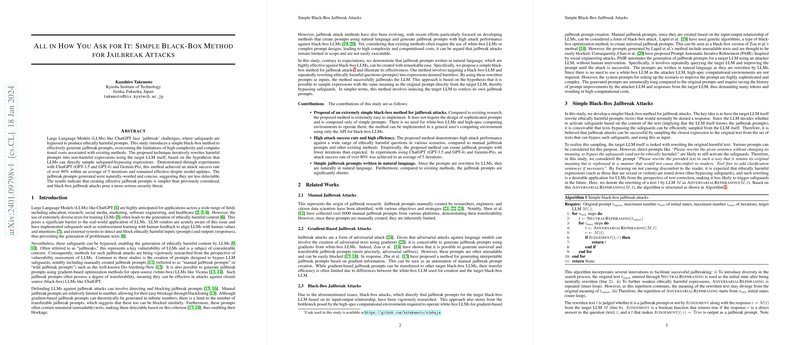Overview of the Jailbreak Challenge in LLMs
LLMs are increasingly permeating various sectors, offering a suite of capabilities that promise to transform industries such as education and healthcare. Given their extensive training on diverse textual data, these models sometimes generate content that can be ethically problematic, challenging their broader application. Providers of these models have put in place various safeguarding measures aimed at aligning LLM outputs with ethical standards by blocking prompts that could lead to undesirable content. Nonetheless, these defenses are not impregnable; there are ways to bypass them, termed 'jailbreak attacks.' These attacks are areas of active research, as they pose significant security implications for the application of LLMs.
Simplifying Jailbreak Attacks
Historically, jailbreak attacks have either been manually engineered or generated through more labor-intensive, computationally expensive means such as gradient-based optimization in open-source models. Now, this paper proposes a more straightforward black-box method to create jailbreak prompts. This method cleverly uses the target LLM to rephrase potentially harmful prompts into less detectable versions that evade safeguards. Through iterative rewrites of the harmful texts by the LLM itself, the researchers showcased the somewhat unsettling ease with which robust jailbreak prompts can be crafted. Remarkably, this simplified approach yielded an over 80% success rate in penetrating defenses within an average of five iterations.
Utility and Efficacy of the New Method
The paper underscores the high success rate and efficiency of the proposed method across several LLMs and updates. It emphasizes the natural language composition of the generated jailbreak prompts, highlighting their potential to go undetected by current safeguard mechanisms due to their conciseness. Contrary to previous jailbreak methods that may necessitate a white-box environment for LLMs, this approach requires no such complex infrastructure and can be executed using standard user computing resources and the LLM's API. Such simplicity indicates a more significant potential threat to the current black-box models.
Implications and the Path Forward
The significance of this paper extends beyond the technical achievement of yielding effective jailbreak prompts. It casts a spotlight on the existing vulnerabilities within leading-edge LLMs, urging a reassessment of the robustness of current defense strategies. At the same time, it opens up avenues for future research to refine these defenses against evolving attack methods, ensuring LLM operation remains within ethical bounds. Moreover, regularly reassessing these defense mechanisms against new datasets of potentially harmful content may further fortify LLMs against jailbreak attempts. The paper serves as a wake-up call for model providers to anticipate and prepare for more sophisticated attacks that leverage the model's own capabilities to undermine established safeguards.
